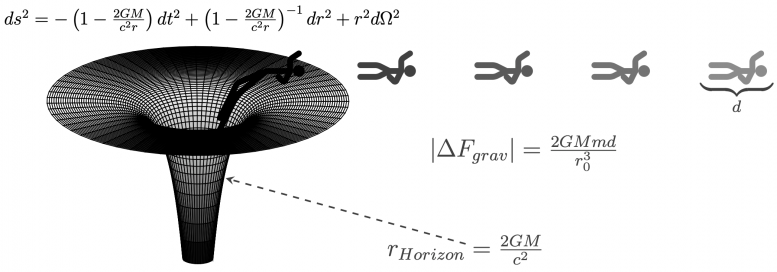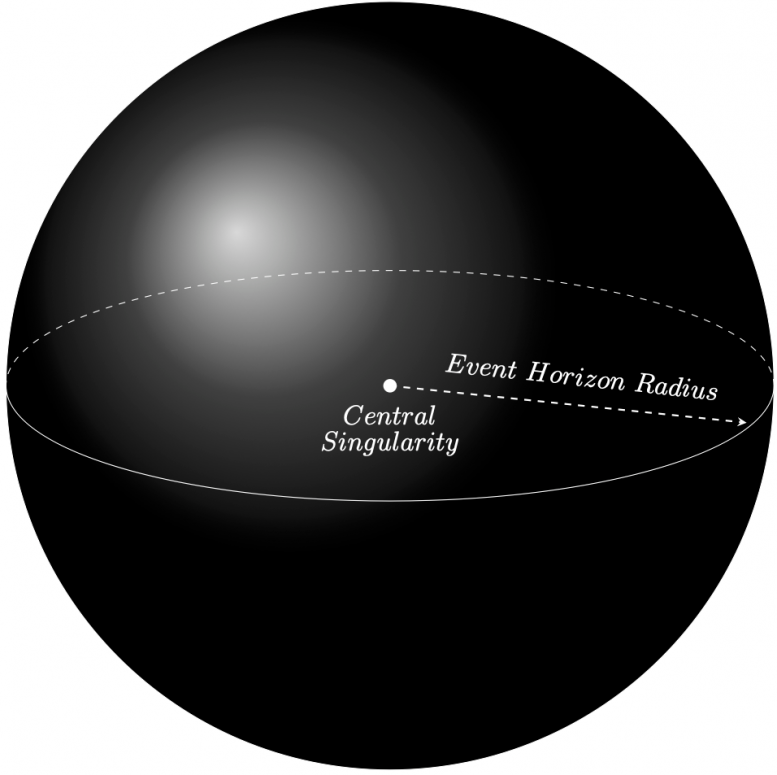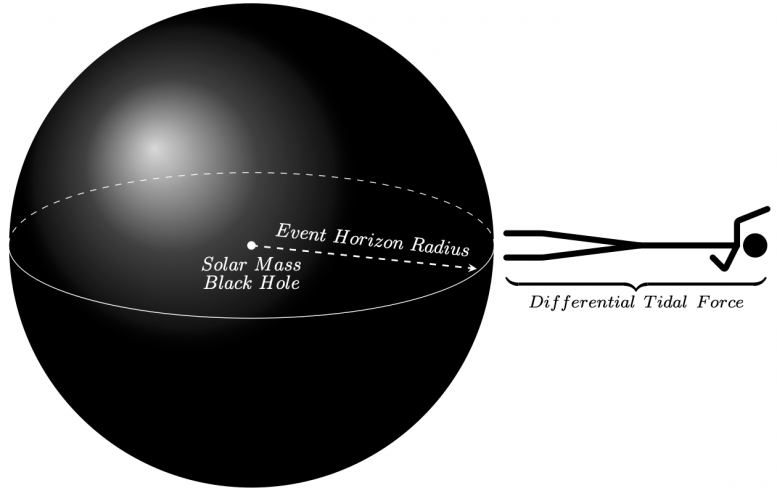
Posted on 04/06/2021 9:46:53 AM PDT by Red Badger

A person falling into a black hole and being stretched while approaching the black hole’s horizon. Credit: Leo Rodriguez and Shanshan Rodriguez, CC BY-ND ===================================================================
To solve the mysteries of black holes, a human should just venture into one. However, there is a rather complicated catch: A human can do this only if the respective black hole is supermassive and isolated, and if the person entering the black hole does not expect to report the findings to anyone in the entire universe.
We are both physicists who study black holes, albeit from a very safe distance. Black holes are among the most abundant astrophysical objects in our universe. These intriguing objects appear to be an essential ingredient in the evolution of the universe, from the Big Bang till present day. They probably had an impact on the formation of human life in our own galaxy.
Two types of black holes The universe is littered with a vast zoo of different types of black holes.
They can vary by size and be electrically charged, the same way electrons or protons are in atoms. Some black holes actually spin. There are two types of black holes that are relevant to our discussion. The first does not rotate, is electrically neutral – that is, not positively or negatively charged – and has the mass of our Sun. The second type is a supermassive black hole, with a mass of millions to even billions times greater than that of our Sun.
Besides the mass difference between these two types of black holes, what also differentiates them is the distance from their center to their “event horizon” – a measure called radial distance. The event horizon of a black hole is the point of no return. Anything that passes this point will be swallowed by the black hole and forever vanish from our known universe.

The distance from a black hole’s center of mass to where gravity’s pull is too strong to overcome is called the event horizon. Credit: Leo and Shanshan, CC BY-ND
At the event horizon, the black hole’s gravity is so powerful that no amount of mechanical force can overcome or counteract it. Even light, the fastest-moving thing in our universe, cannot escape – hence the term “black hole.”
The radial size of the event horizon depends on the mass of the respective black hole and is key for a person to survive falling into one. For a black hole with a mass of our Sun (one solar mass), the event horizon will have a radius of just under 2 miles.
The supermassive black hole at the center of our Milky Way galaxy, by contrast, has a mass of roughly 4 million solar masses, and it has an event horizon with a radius of 7.3 million miles or 17 solar radii.
Thus, someone falling into a stellar-size black hole will get much, much closer to the black hole’s center before passing the event horizon, as opposed to falling into a supermassive black hole.
This implies, due to the closeness of the black hole’s center, that the black hole’s pull on a person will differ by a factor of 1,000 billion times between head and toe, depending on which is leading the free fall. In other words, if the person is falling feet first, as they approach the event horizon of a stellar mass black hole, the gravitational pull on their feet will be exponentially larger compared to the black hole’s tug on their head.
The person would experience spaghettification, and most likely not survive being stretched into a long, thin noodlelike shape.

As the person approaches the event horizon of a a Sun-size black hole, the vast difference in gravitational pull between the inidvidual’s head and toes causes the person to stretch into a very long noodle, hence the term ‘spaghettification’. Credit: Leo and Shanshan Rodriguez, CC BY-ND
=========================================================================
Now, a person falling into a supermassive black hole would reach the event horizon much farther from the central source of gravitational pull, which means that the difference in gravitational pull between head and toe is nearly zero. Thus, the person would pass through the event horizon unaffected, not be stretched into a long, thin noodle, survive and float painlessly past the black hole’s horizon.

A person falling into a supermassive black hole would likely survive. Credit: Leo and Shanshan Rodriguez, CC BY-ND
==================================================================
Other considerations Most black holes that we observe in the universe are surrounded by very hot disks of material, mostly comprising gas and dust or other objects like stars and planets that got too close to the horizon and fell into the black hole. These disks are called accretion disks and are very hot and turbulent. They are most certainly not hospitable and would make traveling into the black hole extremely dangerous.
To enter one safely, you would need to find a supermassive black hole that is completely isolated and not feeding on surrounding material, gas, and or even stars.
Now, if a person found an isolated supermassive black hole suitable for scientific study and decided to venture in, everything observed or measured of the black hole interior would be confined within the black hole’s event horizon.
Keeping in mind that nothing can escape the gravitational pull beyond the event horizon, the in-falling person would not be able to send any information about their findings back out beyond this horizon. Their journey and findings would be lost to the rest of the entire universe for all time. But they would enjoy the adventure, for as long as they survived … maybe ….
Written by Leo Rodriguez, Assistant Professor of Physics, Grinnell College and Shanshan Rodriguez, Assistant Professor of Physics, Grinnell College.
Originally published on The Conversation.The Conversation
I took a cosmology course (as opposed to cosmotology) in Graduate school decades ago. Was an elective to my Aeronautics/Astronautics major. I dont recall much but since you seem current on such phenomena, I will ask, “how can anything, even x-rays and radiation, escape the gravity well where not even light can escape?”
Then there is the Great Attractor, toward which the entire Universe is moving. Is it a super mega gigantic stupendous ultra dense massive black hole? We don’t know because it is obscured by dust clouds from our Earthly vantage point.
Or is it some sort of construction by some ultra advanced beings who have existed since the beginning of the Universe, made to open a gateway between multiple Universes? See Stephen Baxter’s “Xeelee” series for hard science speculation on such a thing.
Particle-antiparticle creation on the cusp of the event horizon? One falls in leaving the other to avoid an annihilation event, thus it continues existence in this universe as a real particle.
Hawking Radiation
What’s the point though? May as well just look at a cue ball. It is round and dense. The end.

They aren’t coming from inside the event horizon, but rather from close to it. Much like the water in your bath tub doesn’t simply flow directly into the drain - but rather swirls around it - matter will tend to do the same with a black hole (or really any object with mass). Consider as well that a black hole that doesn’t spin (a Schwarzschild black hole) probably doesn’t exist. So you add frame-dragging into the mix as well and you have even more reason to pull matter into the plane of spin rather than directly into the black hole.
Now when we talk about Hawking radiation, this is where the quantum world meets the observable universe in a weird way. Those quantum effects (essentially random particle-antiparticle pair creation) happen everywhere, but at the event horizon of the black hole, they can happen in such a way that they become real (rather than virtual particles), sending a particle of matter or antimatter flying off away from the black hole (just outside the event horizon) at close to the speed of light. The larger the black hole, the more surface area there is for the event horizon, which is the only place this should ever happen.
The reason you aren’t getting anything out of the black hole’s event horizon is that inside that, time itself points toward the singularity at the center. So it isn’t a matter of coming up with sufficient power to escape since the future itself - from the perspective of the observer inside the event horizon - is toward the singularity. We can normally distinguish between our three spacial dimensions and a time dimension, but the interior of the black hole is such an extreme environment that all must be considered together. You can no more go from inside the black hole to outside than you can go from April 6th 2021 to April 5th 2021. You’re going toward April 7th 2021 no matter what you do. With sufficient speed, you can slow that journey (from an outside observer’s perspective), but you’ll never reach April 5th. Moving from inside the event horizon to the outside would - by definition - require you to go back in time.

Oh come on, I know I wasn't the only one thinking it.
Well, nobody emerges from a black hole.
The radiation isn’t actually coming from inside the black hole, so it isn’t “escaping”. It’s being radiated from the outside of the black hole.
Thanks, that sounds like particle physics beyond my area of expertise.
Virtual particles are weird to begin with, but get worse when you look at force messenger virtual particles. It almost feels like a really lazy solution to the problems that come up (e.g. inability to transmit forces inside a sufficient gravity well - oh but wait nevermind, because Feynman said virtual particles don’t need to obey any rules in nature except causality.)
“The door swings both ways.” —Egon Spengler
I'm going to go find my Delorean with Mr Fusion now...
“It almost feels like a really lazy solution to the problems that come up”
More like mathematical shorthand than a lazy solution. We can describe the phenomenon with the same math that works to describe particles, so we use it. Same as with “pseudoparticles” like phonons.
Personally, I think in the end we’ll figure out that the “real” particles are exactly the same, just emergent phenomenon of wave/field mechanics that we can describe as particles in certain situations for expediency.
Like a fly trapped in amber is the way I heard it described.
Of course, the radiation would have killed them on the way there.
That actually makes a lot of sense to me as well. I think the distinction bugs me more than anything; as I doubt nature does any such thing. That we're seeing any distinction just tells me we're likely missing part of that puzzle. Still fascinating to me to consider the level of complexity and persistence that can be achieved with the random variations and fluctuations at the quantum level. The smoothing that must take place at the macro levels to support things like planetary formation is incredible. Everything around us appears to be an average of averages of randomness, yet it all works predictably.
Ask Joe
Heck, just go to Chicago.
Disclaimer: Opinions posted on Free Republic are those of the individual posters and do not necessarily represent the opinion of Free Republic or its management. All materials posted herein are protected by copyright law and the exemption for fair use of copyrighted works.